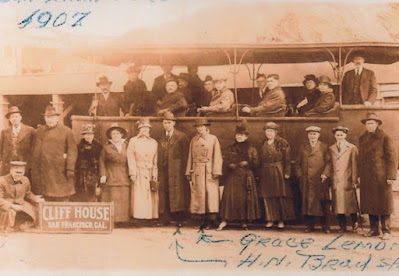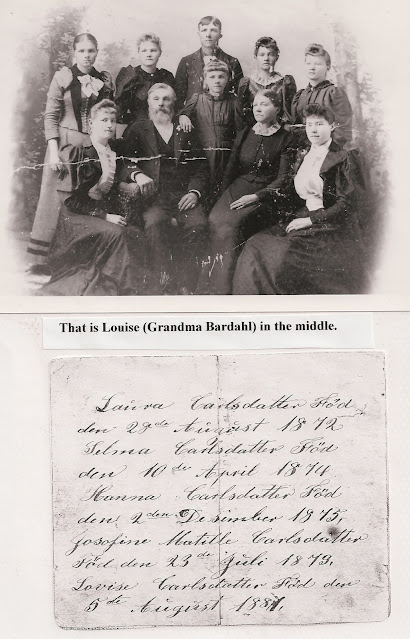For several years, the database for my Swedish 5X great grandmother has indicated that "I need to resolve conflicting birth and death dates and two sets of possible parents for Elin." This final story for 2020 seems like a good time to see if I can make any progress toward a resolution. And, if not, perhaps this is slated to become a resolution for further research in 2021.
 |
| Laxarby Church photograph 2018 by Vogler Wikimedia Commons under creative commons license https://creativecommons.org/licenses/by/3.0/deed.en |
The Swedish branch of my mother's family is on her paternal Anderson line, with immigrant ancestor Israel Anderson. Elin Persdotter was Israel's great grandmother. (Israel's story was the first one I wrote five years ago when I last did the "52 Ancestors" challenge, making it appropriate to bookend this year by ending with one of his Swedish ancestors.)
Elin appears in the marriage record for 1 January 1765 showing Elin Persdotter of Germundebyn marrying Nils Enarsson of Prestegarden in Laxarby, Älvsborg, Sweden.
 |
| Laxarby, Älvsborg Marriage 1 January 1765 |
Nils moved from Prestegarden to Elin's family area at Germundebyn where records for their growing family are easily found. Birth/baptism records from the Laxarby church books can be found for the following children:
- Britta Nilsdotter b. 17 January 1766 (my 4X great grandmother)
- Olof Nilsson b. 16 January 1768
- Enar Nilsson b. 23 November 1770
- Pehr Nilsson b. 5 April 1774
- Ingrid Nilsdotter b. 11 March 1777
- Bryngel Nilsson b. 14 July 1779.
(As an aside, a census of Laxarby today would not yield a significant population; apparently fewer than 900 people now live in the area. At the time my Anderson ancestors lived there, Laxarby was part of Älvsborg, but in the late 1900s it became a part of Västra Götaland.)
 |
| Laxarby, Sweden location of Elin's family, Google Earth |
Among the best sources of information for Swedish families are the Husförhörslängd (household examination records kept by the State Lutheran Church). These are essentially annual censuses of all family members. The Household Examination Records for Nils and Elin's family make it easy to follow them from year to year between 1774 and 1810. Nils and Elin disappear from the household examination records after 1810.
 |
| Household Examination Record for Nils and Elin's family 1774-1779 |
The record for the period 1795-1800 is of interest since it records that my 4X great grandmother Britta has left the family to marry and move to Korsbyn.
 |
| Household Examination Record for Nils and Elin's family 1795-1800 |
The problem requiring resolution is that there are records for two different Elin Persdotters in Laxarby in the relevant time period. For a long time, the only record I had located was for Elin Persdotter born in December of 1741 to Per Egelsson and Christin Jonsdotter. (Most online family trees use this Elin with these parents for my family group.)
 |
| Elin, daughter of Per Egelson and Christin Jonsdotter, born in Laxarby in 1741 |
Then, an indexed source pointed in another possible direction. There was an Elin born 24 March 1739 and baptized the following day at Laxarby to parents Per Olsson and Ingri Jonsdotter. However, the original church record is almost unreadable,
 |
| Birth/baptism record for Elin, daughter of Per Olsson and Ingrid Jonsdotter, 1739 Laxarby church records |
 |
| 1757 Household Examination Record for Germundebyn farm |
Most likely this is Elin's family since it is on the right farm (Germundebyn in Laxarby Parish) and has the possible mother (Ingrid Jonsdotter) but it seems that Elin's father Per has probably died and the farm is now being run by a man named Bryngel Mathisson. One possible death record for Per (Pehr) Olsson has been located but I have a difficult time convincing myself that I can actually read his name for this 50 year-old who died at Germundebyn in 1748.
 |
| Possible death record for Per Olsson 18 February 1748 |
Two brothers of Elin's also appear in the household record family group: Jon Persson b 1735 and Olaf Persson b1740. There is also a child named Jacob (could it be Bryngelsson?) born in 1749. Finding their birth records is definitely in order as part of this whole resolution process.
Has Ingrid remarried to a man 19 years her junior or what is the explanation for this family group? Ingrid would have been 49 years old when this child was born, so this seems unlikely. Who was Bryngel and how does he connect to the family? I'm finding more things to muddy the waters - and more things requiring further research!
Elin's birth year is consistently recorded in the household examination records as 1739, leading me to conclude that she was NOT the Elin born in 1741. These records continue through 1810, but for 1811, both Nils and Elin are no longer included in the family listing. Their death records occur on opposite pages in the church records, his in 1809 at age 70 and Elin's 6 May 1810, also at age 70. She was buried 20 May 1810 at Laxarby.
 |
| 1810 Death record for Elin Persdotter of Germundebyn |
Once again there was a record of another Elin Persdotter (quite probably the one born in 1741) who died in 1812. Unfortunately, no marriage or household examination records have been located for this other Elin Persdotter.
 |
| Death of an Elin Persdotter in 1812 at age 75 |
Given "my" Elin's disappearance from the Household Examination Records for 1811, coupled with mention of the Germundebyn farm in her death record, it is most likely that she was the Elin who died in December of 1810.
Have my issues been resolved? I believe it is most likely that my Elin Persdotter was the one born in 1739 to Per Olsson and Ingrid Jonsdotter and that she died in 1810.
More research will definitely be required for some of the other issues uncovered, but I think that belongs in my list of 2021 New Year's Resolutions.
Some Resources:
- Familysearch Research Wiki for Sweden, accessible online at https://www.familysearch.org/wiki/en/Sweden_Genealogy














































